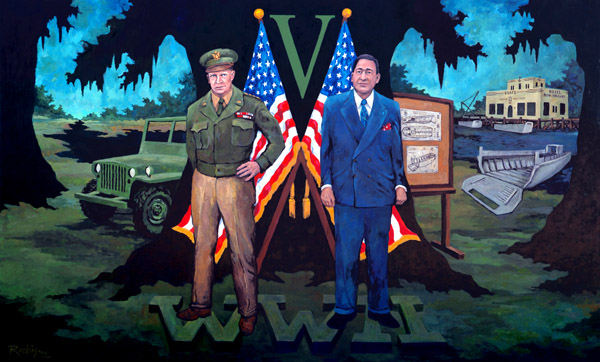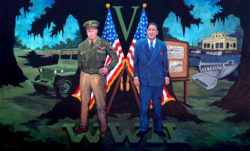World War II
The Second World War allowed for economic growth and increased opportunities for women and African Americans in Louisiana.
This entry is 8th Grade level View Full Entry

Courtesy of George Rodrigue.
A painting by George Rodrigue depicting Andrew Higgins and Dwight Eisenhower, 2009.
Federal spending during World War II helped grow Louisiana’s economy. New employment opportunities caused a series of population shifts, especially in the southern part of the state. By 1950 the state of Louisiana had changed from mainly rural to mostly urban. Urban populations grew 39.1 percent from 1940 to 1950, while rural populations declined 4.6 percent. As of 1950 Louisiana had more urban residents (50.8 percent) than rural residents (49.2 percent). World War II also led to changes in social systems, educational facilities, gender roles, and race relations.
How did military training facilities in Louisiana expand during World War II?
The federal government built new military facilities and expanded existing ones during World War II. Between the end of World War I and the beginning of World War II, Camp Beauregard in Rapides Parish served as a training camp for the Louisiana National Guard, and in 1940 it was reactivated as a US Army training camp. Construction of Camps Livingston and Claiborne in Rapides Parish and Camp Polk in Vernon Parish rapidly followed. Camps like these and others around the state trained soldiers, created construction jobs, and created new markets for local farmers.
The Louisiana Maneuvers began in 1940 as a series of US Army training drills. The 1941 maneuvers were the largest training exercises conducted by the army during peacetime. They brought soldiers into Louisiana, which helped fuel the state’s economy with their spending. Many top military commanders came to central Louisiana to either command troops or observe the exercises, including George Marshall, Dwight Eisenhower, George Patton, Joseph Stilwell, and Omar Bradley. The maneuvers are remembered not only as important training sessions but also as business opportunities for local merchants who saw the soldiers as potential customers. The drills came to an end in 1944, when the troops were dispatched to the D-Day invasion of France.
How did the war effort affect Louisiana’s economy?
The state’s agriculture and industry benefited from the war effort. Louisiana farmers recovered from the Great Depression by growing sugarcane, cotton, and rice, the traditional trinity of Louisiana agriculture. During World War II increased industrialization helped grow Louisiana’s economy, as factories provided vital raw materials, manufactured goods, and petrochemicals for the war effort. While New Orleans was the state’s major industrial center, Baton Rouge, Shreveport, Monroe, Alexandria, Lafayette, and Lake Charles also played important roles. In Shreveport, for example, the J. B. Beaird Company employed approximately eight hundred people to make shell casings, tanks for the production of synthetic rubber and storage of high-octane gasoline, landing barge anchors, and armored tank parts. Industrial production increased slightly in other towns as well. In 1941 the War Department announced plans to build an ordnance (military supplies) plant near Shreveport in northwestern Louisiana, consisting of 430 buildings.
Andrew Higgins and Higgins Industries created the state’s largest wartime industry in New Orleans. The company’s most famous product was the Higgins boat, a landing craft used in amphibious landings in both the European and Pacific theaters. Higgins Industries also built Liberty ships in New Orleans, while Consolidated Vultee, a California business, built airplanes in the city. Wartime needs prompted the creation or expansion of many small businesses throughout the state.
Demand for war materials, industrial production, and a shortage of manpower due to the number of men at war limited the labor pool. In agriculture, for example, many farmers relied on the labor of German and Italian prisoners of war kept in the state. By 1945 approximately fifteen thousand prisoners of war were engaged in agricultural labor in Louisiana. The success of their efforts varied according to the crop and the prisoners’ abilities.
How did the war affect African Americans and women in Louisiana?
African Americans and women, two groups historically denied access to many opportunities, joined the wartime labor pool. Many African Americans moved out of low-paying jobs and into more profitable employment opportunities formerly dominated by white men. Louisiana’s system of segregation, often referred to as Jim Crow, persisted, and many Black workers encountered racism. Women, who were usually relegated to volunteer work, housework, or “women’s jobs,” such as teaching or nursing, became stock board markers, parking lot attendants, taxicab drivers, welders, aircraft mechanics, newspaper deliverers, machinists, and store managers, among other jobs.
What challenges did Louisianans experience during the war? How did they respond?
Despite the economic prosperity brought by the war, World War II also restricted and limited the lives of many Louisianans. Some consumer goods were taken off store shelves, and others were difficult to get. To get sugar, for example, residents had to sign up for sugar-rationing books. As Louisianans with wartime jobs suddenly had money to spend after years of going without during the Great Depression, the shortages were frustrating. Gasoline rationing and tire shortages, for example, restricted Americans’ freedom to travel.
Louisianans participated in the struggle against totalitarianism through civilian defense, scrap collection drives, and war bond sales. War stamps and bonds were sold in stores. Newspaper delivery boys also sold war stamps, and air raid wardens scanned the skies for enemy planes. Each war bond drive exceeded the state’s sales quota because Louisianans bought so many stamps and bonds. Louisianans also contributed to the war effort by searching piles of junk for recyclable materials. In addition to donating scrap metal, they donated kitchen utensils and other objects from the Civil War– and World War I–eras.
What long-term effects did World War II have on Louisiana?
Historians continue to debate World War II’s impact on Louisiana. Some historians stress that the southern states emerged from the war with very different social and economic conditions from those of 1939. The changes in Louisiana generally support this interpretation, even though many prewar aspects of life returned after the war. Louisiana’s military training camps were either abandoned or reduced after the troops left, but other wartime changes proved harder to reverse. The advancements made by African Americans and women, for example, weren’t the end of their fight for equality. Many women returned to traditional roles after the war, and African Americans continued to fight against Jim Crow. For many though their wartime experiences provided a foundation for the ongoing struggle to achieve equality.
